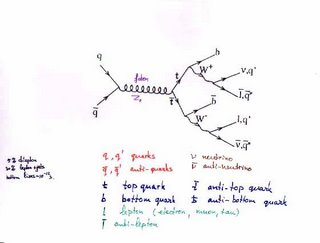Of course, Lovecraft is alluding to Riemannian (as opposed to Euclidean) geometry and playfully merges it with pentacles and witches drawings of qaabalist sketches. Hathorne is clearly an allusion not just to the real judge, but to Nathaniel Hawthorne and his witch & "black man"* tales.
This is parody, but as I read this passage, it excited me to realize how often Lovecraft was prescient. Years afterward, Feynman would come up with eerie glyphs to illustrate quantum interactions.

Richard Feynman was a 20th century physicist who developed a "thought diagram" still used today to calculate rates for electromagnetic and weak particle processes. The diagrams provide a convenient shorthand for the calculations. They are a code physicists use to talk to one another about their calculations.
In Feynman diagrams Left-to-right in the diagram represents time; a process begins on the left and ends on the right. Every line in the diagram represents a particle; the three types of particles in the simplest theory (QED) are:
straight line, arrow to the right - electron
straight line, arrow to the left - positron
wavy line - photon
Up and down indicates motion
Any point where three lines meet represents an electromagnetic interactio
The most interesting is when an electron and a positron meet and annihilate (disappear), producing a photon.
* A "black man" is an image of the devil, i.e. Satan, and has nothing to do with race. Despite Lovecraft's elitist racism, this usage is consistent with seventeenth century understanding of witchcraft and is often used in Cotton Mather and transcripts of the Salem Vuillage trials.

No comments:
Post a Comment